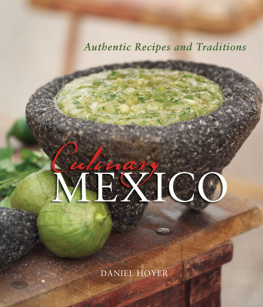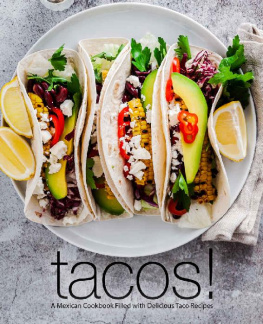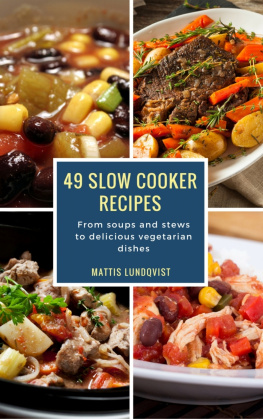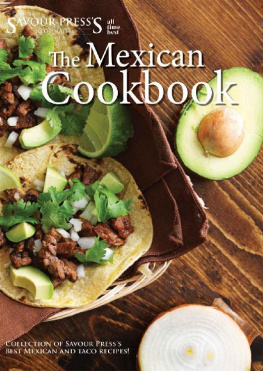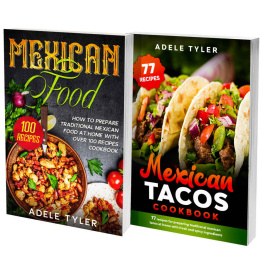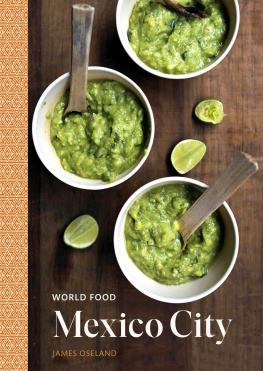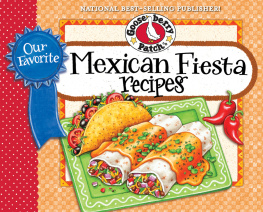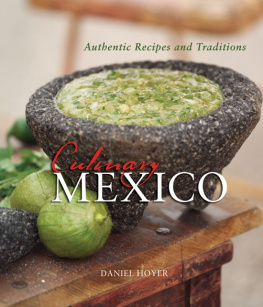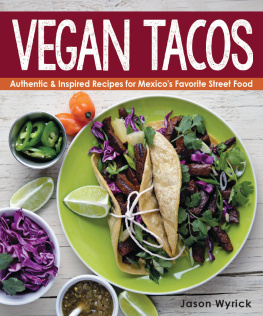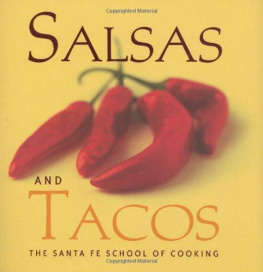Culinary Mexico
Authentic Recipes and Traditions
Daniel Hoyer
Photographs by Marty Snortum

Culinary Mexico
Authentic Recipes and Traditions
Digital Edition 1.0
Text 2011 Daniel Hoyer
Photographs 2011 Marty Snortum
All rights reserved. No part of this book may be reproduced by any means whatsoever without written permission from the publisher, except brief portions quoted for purpose of review.
Gibbs Smith
P.O. Box 667
Layton, Utah 84041
Orders: 1.800.835.4993
www.gibbs-smith.com
ISBN: 978-1-4236-0946-9
Dedicated to
Ian Hoyer
November 9, 1985-July 30, 2004
Ian, you more than anyone else, always believed in me. If not for your constant encouragement and nonjudgmental support, I might never have completed this book. You were never afraid and I continue to draw strength from you. I miss you sorely and treasure your memory. I can still see your smile, taste your cooking, and hear your music every day. You deeply touched so many people, so much more than you ever realized. I will always wonder what more you might have accomplished. I love you with all my heart. Peace.
Contributions to the Ian Hoyer Memorial Music Fund may be sent to:
Chamisa Mesa Educational Center
P.O. Box 759
Ranchos de Taos, New Mexico 87557
(505) 7510943
Acknowledgments
The task of thanking everyone who has helped me over the years to get to where I am now is daunting to say the least. So many people have contributed to my knowledge, and many others have provided inspiration, support, and encouragement, that it is difficult to know where to start. To those of you I fail to mention below, thank you; I am sorry to omit your names but please know that you are appreciated.
To Nancy: your love, support, and steadiness have always been there to keep me on track. Thanks for taking care of the details of life while I get lost in my projects and for being a willing test subject for my cooking.
Tristan, thank you for your interest in and your unquestioning acceptance of my life choices. I am sorry that I monopolized the computer so much. You continue to amaze me.
Thanks to my grandmothers and my mom for letting me follow them in the kitchen as a young boy, full of incessant questions; also, for trusting me to make the mashed potatoes and gravy for Sunday dinners.
To Beto and Doug, thanks for joining me on an important leg of my journey.
To all of the people I have worked with in restaurants over the yearsco-workers, bosses, and employees, and especially my amigos y compadres Mexicanos: You have taught me most of what I know about food.
Many chefs and cookbook authors have inspired, guided, and informed me throughout my cooking career, most notably Rick Bayless, Diana Kennedy, Mark Miller, Patricia Quintana, Susana Trilling, Iliana de la Vega, Marilyn Tausend, Julia Child, and James Beard.
A special thank you to Susan, Nicole, Noe, and all of the staff and chefs at the Santa Fe School of Cooking. You have presented me with many opportunities, shared your secrets, and become an extended part of my family.
To Jennifer Grillone, this books editor: You have maintained a positive and cheerful presence throughout my creative ups and downs and lifes tragedies. Thanks for your patience.
I also wish to express my deep appreciation to all of the cooks in Mexico, from the distant past all the way to the present, who have contributed to the creation, development, and preservation of this magnificent cuisine.
Finally, thanks to Roy, David, Rafa, Doa Angela, Doa Rafaela, Doa Carmen, Erica, Maximiliano, and hundreds of other wonderful people who helped me in the discovery of my affinity to and love for the incredible land of Mexico.
Introduction
What do most North Americans and Europeans think of when asked to describe Mexico? Mariachi music and picturesque beaches with palm trees waving in the wind; cactus, tequila, and margaritas; Pancho Villa, Hernn Cortez, Agustn Lara, and Montezuma; ancient pyramid ruins and colonial cathedrals; bullfights; and, of course, spicy food.
These images are all part of Mexico; however, when it comes to the food, there is much more to Mexicos gastronomy than tacos, enchiladas, burritos, and refried beans, all covered with melted cheese. Until recently, much of the Mexican food served north of the border and in Europe had been adapted to suit the tastes of gringos and was narrowly focused, given the limited availability of ingredients as well as the incomplete knowledge of restaurant owners regarding diverse preparation techniques.
The stereotypical view of Mexican cuisine is beginning to change as more and more emigrants from Mexico are settling in communities throughout the United States. Moreover, Mexico has become a very popular travel destination for Americans as well as Europeans. Many chefs have been discovering the wide range of flavors in authentic Mexican foods (helped, in part, by the fact that many Mexican emigrants have found employment as kitchen workers in U.S. restaurants).
Mexico has a rich history, a varied geography and climate, and a myriad of cultural influences that are reflected in its food. Contrast the barbacoa of the Central Colonial region with the black mole of Oaxaca and bring in the pork in orange sauce from the Yucatan and you might think that the dishes represent three completely different countries! In a way, they do. Each of these preparations were developed in their respective regions by the influences of available ingredients, trade practices, and local economies, and the cultures of indigenous peoples, explorers, colonial settlers, immigrants, and other countries that were trade partners.
In this book, I hope to help illuminate the rich diversity of Mexican cuisine by dividing the country (albeit arbitrarily) into six gastronomic regions.
La Frontera, the states bordering the United States, Baja California, Sonora, Chihuahua, Coahuila, Nuevo Len, and Tamaulipas
La Costa Oro, the Pacific coast from Sinaloa to Guerrero
El Istmo, the Isthmus of Tehuantepec, including the states of Tabasco, Oaxaca, and Veracruz
La Encrucijada, the crossroads, comprising Mexico City and its surrounding states
El Centro Colonial, the central plains and highlands with the stately colonial cities of Guadalajara, Zacatecas, San Miguel de Allende, Guanajuato, Quertaro, Morelia, and San Luis Potos
La Tierra Maya, including Chiapas, parts of Tabasco, and the Yucatn peninsula
Valid arguments could be made for a different division, and most of the listed areas could be divided further into six or more parts themselves. However, this regional profile suits my description of the various styles and reflects my personal experiences while traveling and studying in Mexico.
The history, traditions, and regional/cultural variations of Mexicos food and cooking make this a truly fascinating subject. The uniqueness of authentic Mexican food also derives from the innumerable individual styles and techniques that are used in its creation. I hope you will come to share my enthusiasm as you experience the recipes, ingredients, and tastes of this cookbook.
My appreciation for good Mexican food started when I was a child in my hometown of Topeka, Kansas. Although not well-known as a hotbed of Mexican gastronomy, it was a major hub of the Atchison, Topeka, and Santa Fe Railroad, and as such, had a long-thriving Mexican community that was first established when immigrant laborers were brought to help construct the railroad. I have fond memories of the Fiesta of Guadalupe each autumn and of the two restaurants, La Siesta and Lucky Five. I will never forget the day in ninth grade when my football teammate Luis Tetuan brought a cooler full of tacos guisados to practice. Made by his mother, the tacos were soft-shelled and filled with chunks of braised meat, potatoes, carrots, and peas. What a revelation! Taco shells didnt need to be fried, you could fill them with things other than ground beef, and cheese was not a necessary addition!

